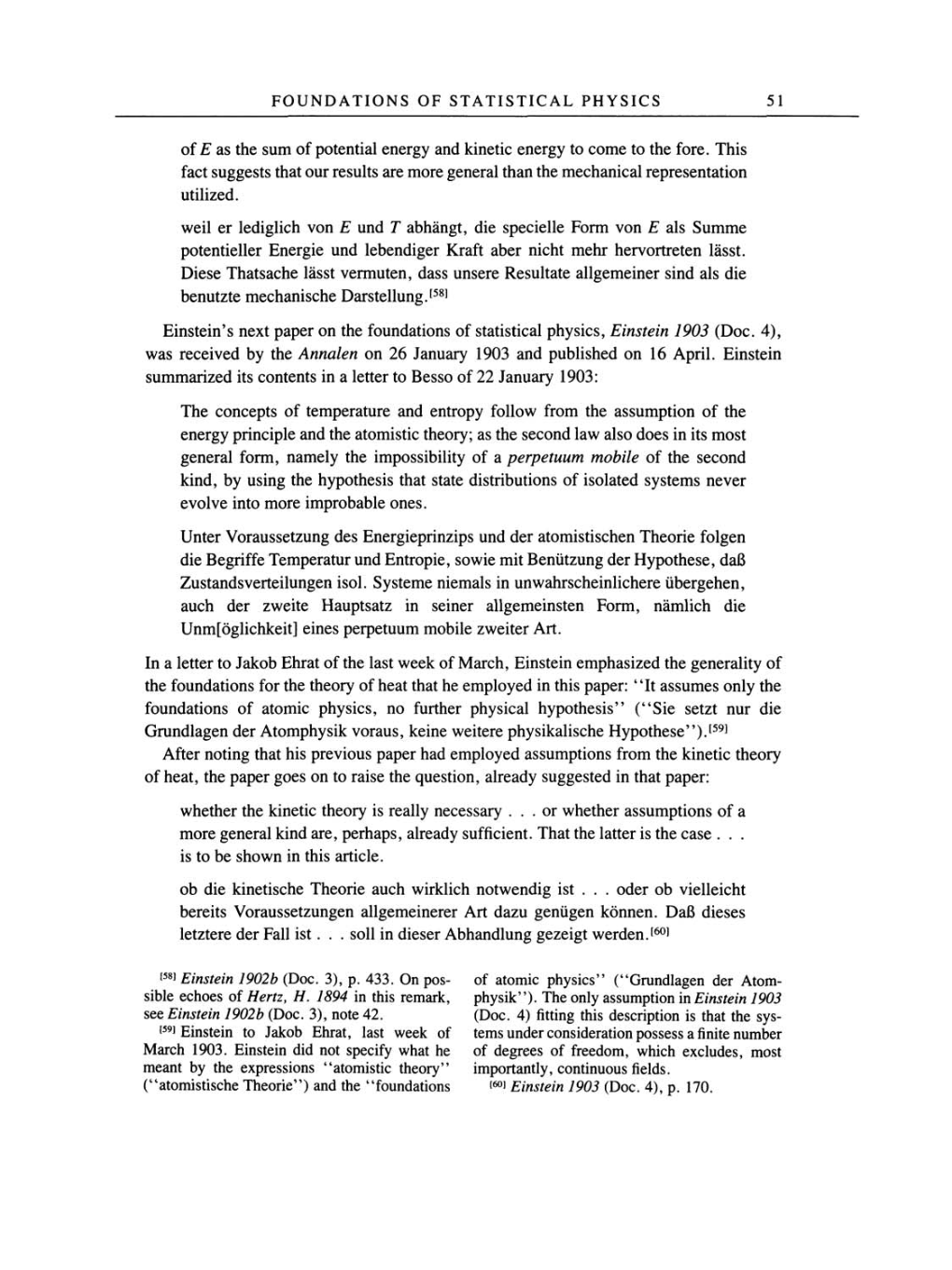FOUNDATIONS
OF STATISTICAL PHYSICS
51
of
E
as
the
sum
of
potential energy
and kinetic
energy
to
come
to the fore.
This
fact
suggests
that
our
results
are more general
than the mechanical
representation
utilized.
weil
er lediglich von
E
und T
abhängt,
die
specielle
Form
von
E
als Summe
potentieller
Energie
und
lebendiger
Kraft aber
nicht
mehr hervortreten lässt.
Diese Thatsache lässt
vermuten,
dass
unsere
Resultate
allgemeiner
sind als die
benutzte mechanische
Darstellung.[58]
Einstein's
next
paper on
the foundations
of
statistical
physics,
Einstein
1903
(Doc. 4),
was
received
by
the
Annalen
on
26
January
1903 and
published on 16
April.
Einstein
summarized its contents
in
a
letter to Besso
of
22
January
1903:
The
concepts
of
temperature
and
entropy
follow from the
assumption
of
the
energy principle
and the atomistic
theory; as
the second law also does in its most
general
form,
namely
the
impossibility
of
a
perpetuum
mobile
of
the second
kind,
by using
the
hypothesis
that state distributions
of
isolated
systems never
evolve into
more improbable ones.
Unter
Voraussetzung
des
Energieprinzips
und der atomistischen Theorie
folgen
die
Begriffe Temperatur
und
Entropie,
sowie mit
Benützung
der
Hypothese,
daß
Zustandsverteilungen
isol.
Systeme
niemals
in
unwahrscheinlichere
übergehen,
auch der zweite
Hauptsatz
in seiner
allgemeinsten Form,
nämlich
die
Unm[öglichkeit]
eines
perpetuum
mobile zweiter Art.
In
a
letter to Jakob Ehrat
of
the last
week
of
March,
Einstein
emphasized
the
generality
of
the
foundations
for the
theory
of
heat that he
employed
in this
paper:
"It
assumes only
the
foundations
of
atomic
physics, no
further
physical
hypothesis"
("Sie
setzt
nur
die
Grundlagen
der
Atomphysik voraus,
keine weitere
physikalische Hypothese").[59]
After
noting
that his
previous
paper
had
employed assumptions
from the
kinetic
theory
of
heat,
the
paper
goes on
to raise the
question, already suggested
in that
paper:
whether the kinetic
theory
is
really necessary
...
or
whether
assumptions
of
a
more general
kind
are, perhaps,
already
sufficient. That the latter
is
the
case
...
is
to be shown
in
this article.
ob die kinetische Theorie auch wirklich
notwendig
ist
...
oder ob
vielleicht
bereits
Voraussetzungen allgemeinerer
Art dazu
genügen
können. Daß
dieses
letztere der Fall
ist
...
soll in dieser
Abhandlung gezeigt
werden.[60]
[58]
Einstein
1902b
(Doc. 3), p.
433. On
pos-
sible echoes
of
Hertz,
H.
1894 in this
remark,
see
Einstein 1902b
(Doc. 3),
note 42.
[59]
Einstein to Jakob Ehrat, last week
of
March 1903. Einstein did not
specify
what he
meant
by
the
expressions
"atomistic
theory"
("atomistische Theorie") and the
"foundations
of
atomic
physics" ("Grundlagen
der
Atom-
physik").
The
only assumption
in
Einstein 1903
(Doc. 4)
fitting
this
description is
that the
sys-
tems
under
consideration
possess a
finite number
of
degrees
of
freedom,
which
excludes,
most
importantly,
continuous
fields.
[60]
Einstein
1903
(Doc. 4),
p.
170.
